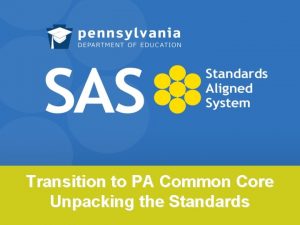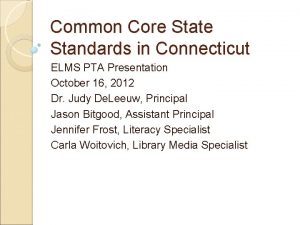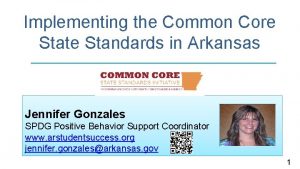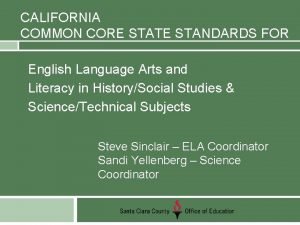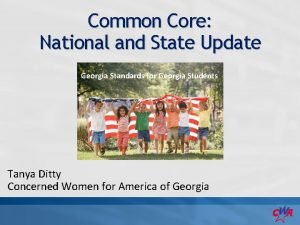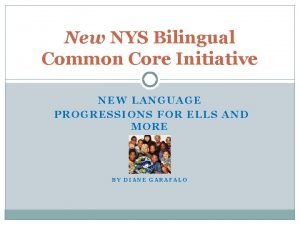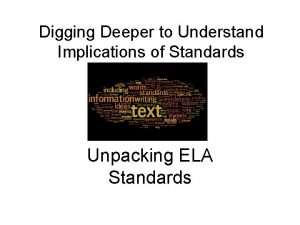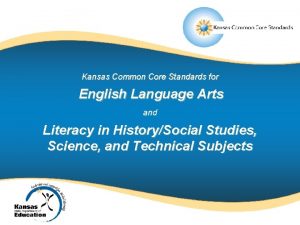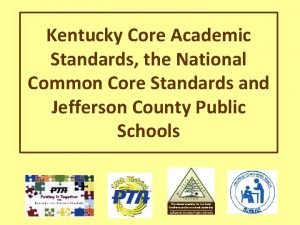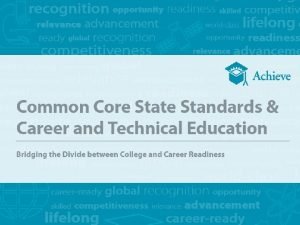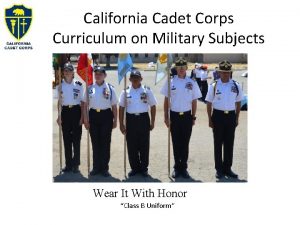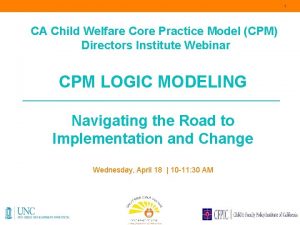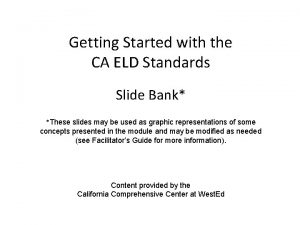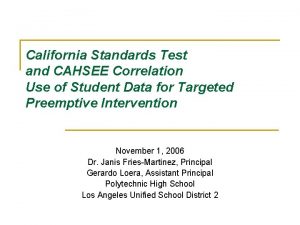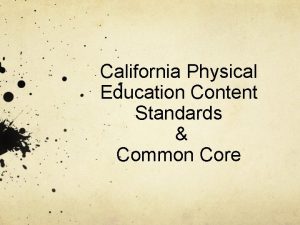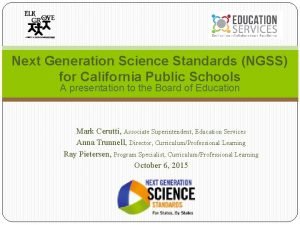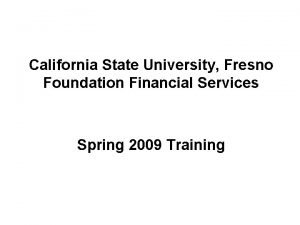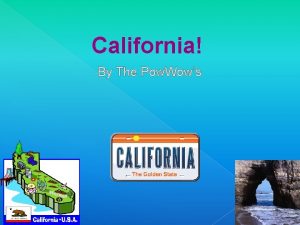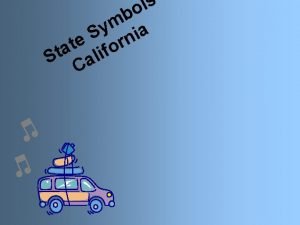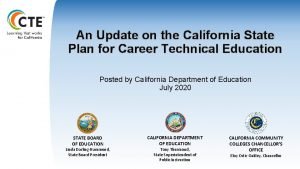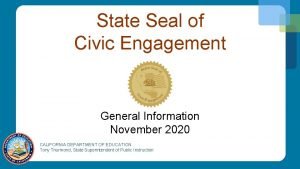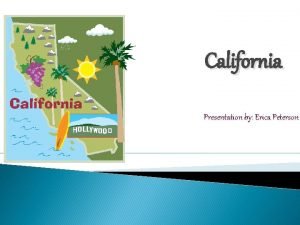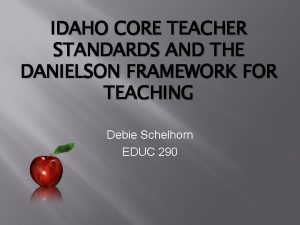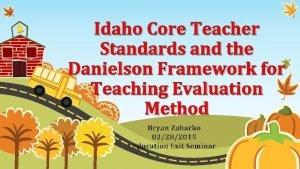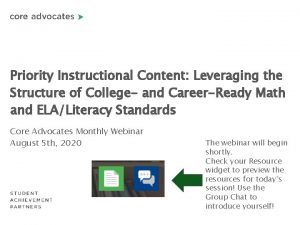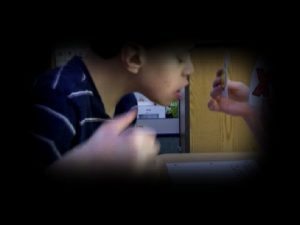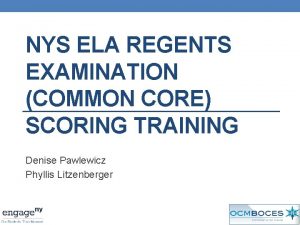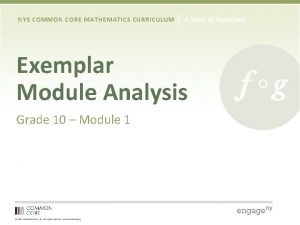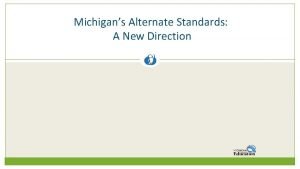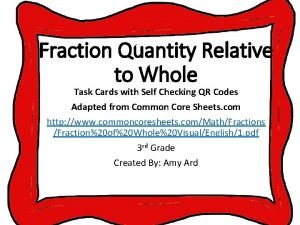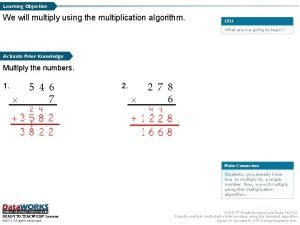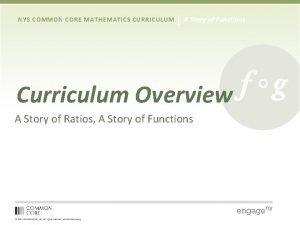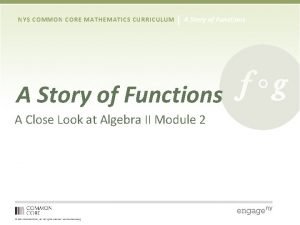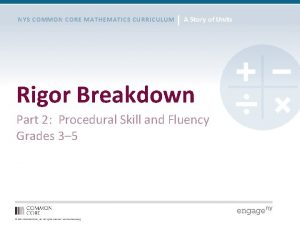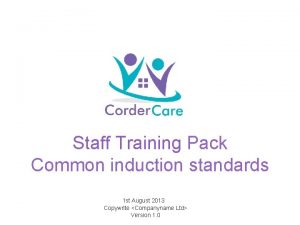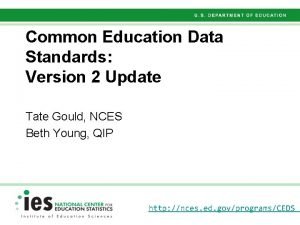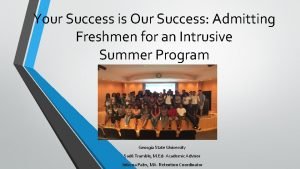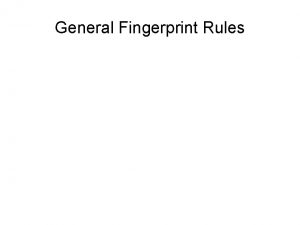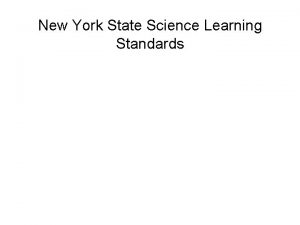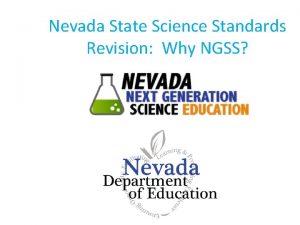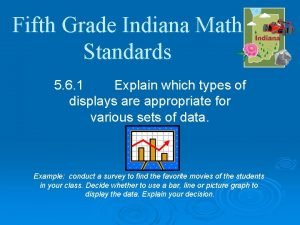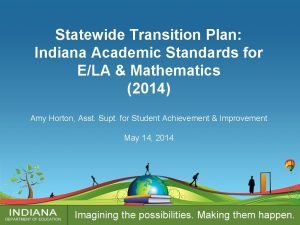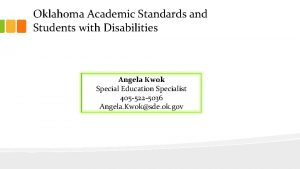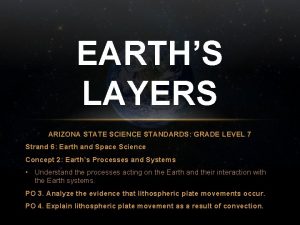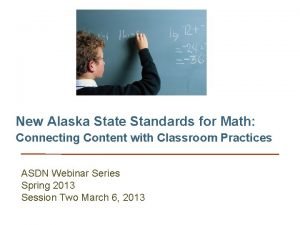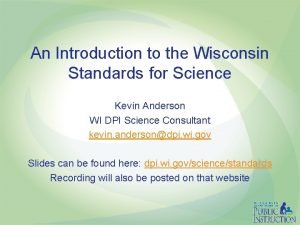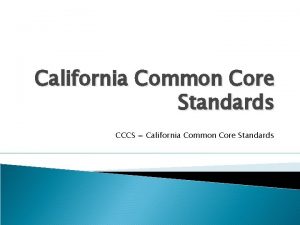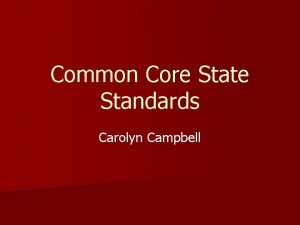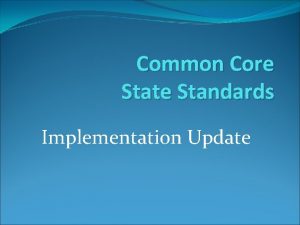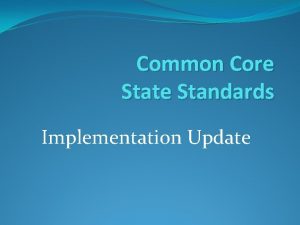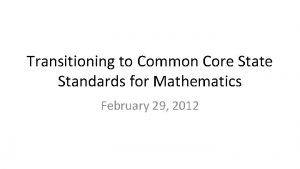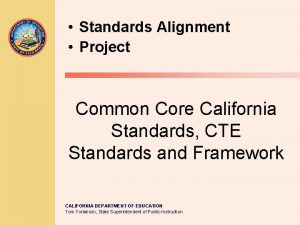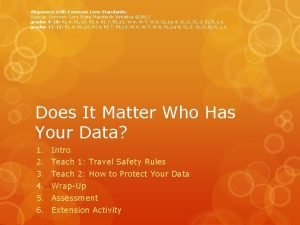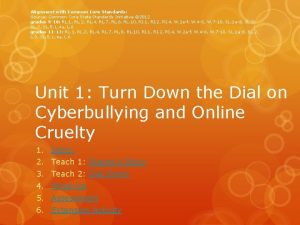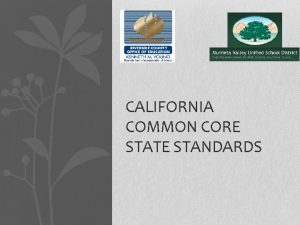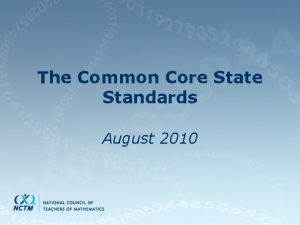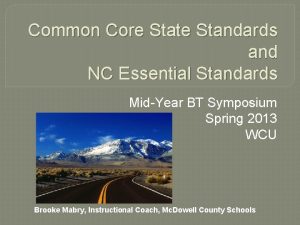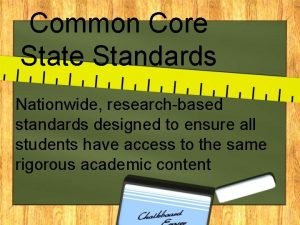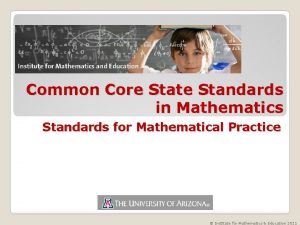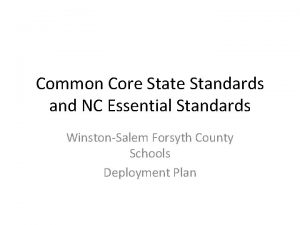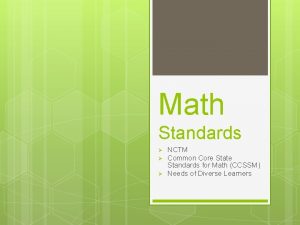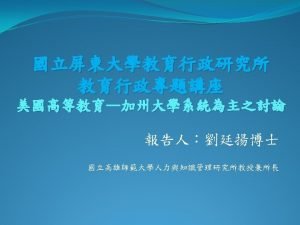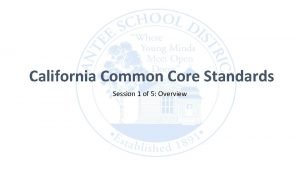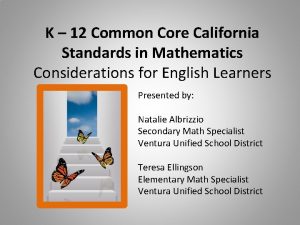Transitioning to California Common Core State Standards SUMMER









































































- Slides: 73

Transitioning to California Common Core State Standards SUMMER INSERVICE– (4 th Grade) READING • Literature • Informational Text • Foundational Skills SPEAKING & LISTENING Presented by: Katy Thomas

Norms • Be present and invested • Collaborate with colleagues • Avoid sidebar conversations during explanations • Set your phone to silent

Outcomes: 1. “Own” the 10 Reading-Literature (RL), the 10 Reading-Informational Text (RIT), and the 2 applicable Reading-Foundational Skills (RFS) standards 2. Utilize social studies and science textbooks for teaching reading 3. Write CCSS-aligned lesson plans using the pacing guide and other resources provided

Noteworthy Changes in Standards Organization: K-5 and 6 -12 K-12 Consistency Emphasis on Expository Text Social Studies/Science Literacy Standards

CCSS Scavenger Hunt PURPOSE: • Explore the legal-sized format • Review the organization of the standards • Discover additional resources within the document DIRECTIONS 1. Choose partners or triads. 2. Using the legal-sized copy of the standards, complete the scavenger hunt handout.

1. Which of all the ELA standards are only found in grades K-5? Reading – Foundational Skills #1 -#4 … Numbers 1 and 2 are only listed for K and 1 st grade since they are to be mastered by the end of 1 st.

2. The three divisions of the reading strand (formerly known as “domain”) are Literature, _Informational. Text_, and__Foundational Skills____.

3. To find an explanation of the three factors considered when measuring text complexity, one could look on page __9__ and discover that the three factors are Reader and Task, __Qualitative___, and ____Quantitative_____.

4. …What do these standards have in common? They all seem to require the same reading skill or strategy but “tweaked” to fit the specific content are (e. g. , “theme” is to literature what “main idea” is to expository text). There’s a parallel nature built in to all of the standards.

5. Find the Language standards for your grade level. What topics/skills are in the Language strand? 1) Conventions (L#1 and L#2): grammar, mechanics, spelling, and capitalization; 2) Knowledge of Language (L#3): Sentence variety, style, tone; and 3) Vocabulary Acquisition and Use (L#4 -L#6): multiple meaning words, context clues, affixes, reference materials, figurative language, word relationships.

6. Identify the three purposes of writing as noted by the writing standards #1, #2, and #3. #1: persuade; #2 inform/explain, and #3 narrate

7. What seems to be the purpose of Reading – Literature #10, Reading – Informational Text #10, and Writing #10? These are application or mastery standards. Technically, the standard doesn’t refer to a specific skill or concept to be taught…just that the student is to be reading literature and informational text at grade-level and writing for a variety of purposes, audiences, and lengths of time.

8. Speaking and Listening standards are divided into which two substrands (indicated by light gray shading)? What are the implications…? 1) Comprehension and Collaboration (SL#1#3); 2) Presentation of Knowledge and Ideas (SL #4 -#6). Implications: students are expected to be verbally processing and working collaboratively on a daily basis.

9. Portions of standards that are in bold, underlined print indicate_____California added this portion to the adopted CCSS.

10. Where could you go to find examples of text that illustrate the complexity, quality, and range of student reading in grades K 5? p. 10; also in Appendix B written by the CCSS authors

FROM: Review of CCSS TO: “Big Picture” of Reading Standards

Two Significant Shifts in Reading: 1. Lexile Level Increase 2. Emphasis on Expository Text

What is a “lexile”? Lexile is the unit used to report text complexity. 2 Factors: Word Frequency Sentence Length These two factors are similar to the “Frye Readability” formula. More info can be found at http: //www. lexile. com/aboutlexile/lexile-overview/

Lexile Framework® for Reading Study Summary of Text Lexile Measures Text Lexile Measure (L) 1600 1400 CCSS Lexile Expectations 1200 Currently Assessed Standards Lexile Expectations 1000 800 600 19 Interquartile Ranges Shown (25% - 75%) High College Military. Personal. Entry. Use Level School Lit. School Texts Occupa Lit. Texts -tions * Source of National Test Data: Meta. Metrics SAT 1, ACT, AP*

1. Lexile level increase CCR= College and Career Ready

2. Emphasis on Expository Text

Weight of Expository Text on CST Vocabulary (1. 0) Reading Comp. (2. 0) Lit. Resp. & Analysis (3. 0) Writing Strategies (1. 0) Written & Oral Lang. Conventions 1. 0) 3 rd 31% 23% 12% 14% 20% 4 th 24% 20% 12% 20% 24% 5 th 19% 21% 16% 21% 23% 6 th 17% 23% 16% 23% 21% Information available on the CDE website – CST Blueprints

Discussion • What AH-HAs or surprises did you have? • What implications for the classroom do the increase in lexile level and emphasis on expository text have?

Focus on Outcome #1: “Own” the 10 Reading-Literature (RL), the 10 Reading-Informational Text (RIT), and the 2 applicable Reading-Foundational Skills (RFS) standards

Compare Reading Standards Directions: 1. Locate the reading – literature standards. q Pages 1 and 2 (3 rd-5 th grades) q Page 12 (6 th grade) 2. Find standard #3 3. Read/trace the standard from kindergarten through 5 th grade. 4. Notice the shifts in complexity but how the standards remain consistent with intent.

K: identify characters; retell 5 th: Compare/ contrast characters/settings 4 th: Describe character, setting, or event 1 st: describe characters, settings, events 2 nd: Describe characters’ response to events 3 rd: Describe characters; explain actions

Activity: Side-by-Side Comparison

Debrief • In looking at the reading literature and informational standards side-by-side, what do you notice about them? • What are the implications for use of the identified vocabulary words in the classroom? • What actions might be done to specifically address the word “text” and the use of “main idea and detail” paired with informational text?

Activity: Highlight Text Dependent Standards

Debrief • How prevalent was “text dependency” within the standards? • What is the significance for instructional planning?

Think-Pair-Share What I learned through these activities was… When planning for instruction I will….

Resource to Apply Content Standards Introducing… the Pacing Guide process for creation!

How was the pacing guide created? 1. ELA Crosswalk produced by SCOE (available on EGUSD website for CCSS)

How was the pacing guide created? 1. (continued) ELA Crosswalk connection to Open Court ” d e h c t a “m s d d e r i f a i t d n n e a Id st

How was the pacing guide created? 2. Converted reference page #s to Excel document- Spot checked validity of OC pages

Activity: Standards Aligned Resource DIRECTIONS: 1. Locate your choice of various standards in the far left column. 2. Use the Standards Aligned Resource to locate specific page numbers identified as support for teaching the CCSS within the TE. 3. Be sure to check the margins for explicit support. 4. Spend 2 -3 minutes with this activity.

Open Court Color-Coded Sections Think about the content/standards that the color-coding sections of green, red, and blue represent in Open Court or if it is even found in Open Court. Preparing to Reading & Responding Language Arts • Word Knowledge • Selection Vocabulary • Writing process • Phonics and Fluency • Comprehension • English Language Conventions • Literary Elements • Spelling • Vocabulary

Connecting Prior Knowledge DIRECTIONS: • Let’s examine CCSS Reading #1 to determine in which color-coded section in O. C. it would be found. • In partners or triads, determine the corresponding color-coded section for the following standards: Ø Reading – Literature #2 Ø Reading – Foundational Skills #3 Ø Writing #3 Ø Language #1 Ø Language #4

Connecting Prior Knowledge Reading – Informational Text #5 – What O. C. resources are available? – Do they provide support for the intent of the standard? – If not, what are the implications?

Table Discussion • What connections to color-coding did you make with the reading standards—both literature and informational text? • How might you use this document as a resource?

Creating the Pacing Guide cont’: 3. Filtered choices through key questions • Standards alignment • Vehicle for standards • “Two-fer” “ • Curricular “holes”

Introducing… the Pacing Guide!

Introduction of Pacing Guide

What if I find that my favorite selection is omitted on the pacing guide? “Fidelity to Program” “Fidelity to Standards”

What if I find that my favorite selection is omitted on the pacing guide? “Fidelity to Program” “Fidelity to Standards” Writing is the one place where the pacing guide will not be absolute…this will be addressed during the Preservice training.

Navigating the Pacing Guide • Take time to look at what resources are available. • Remember that reading standards #1 and #10 are virtually impossible NOT to teach. q#1 = reading comprehension/text evidence q#10 = comprehending gradelevel material

Question & Answer Explore the pacing guide, and as a table, brainstorm a list of any questions you might have. Write your questions collectively on post-it notes.

FROM: TO: Exploring the Pacing Guide Using the Pacing Guide… with a little help from Delaware’s Dept. of Education.

Resources for Reading Questions Thank you to the Delaware Department of Education! http: //www. doe. k 12. de. us/aab/files/EL A/_Linking_Document. pdf

Utilizing the Pacing Guide

Applying the Resource • Highlight existing questions in O. C. , social studies, or, science that would address the reading standards. • Create “post-it note questions” to align to specific standards using the question resource. • Suggestion: focus on creating high-quality questions for standards with the fewest identified resources.

Reflection Fist to five: • When the day began, how would you evaluate your knowledge of CCSS reading standards? • How would you rank your understanding now? Discuss: • The resource that I will use the most is_____ because…

Outcome 2: Utilize social studies and science textbooks for teaching reading Connecting the “what” (standards/curriculum) with the “how” (lesson planning)

Gradual Release of Responsibility

“I do” - Model the Skill

“We do together” – Practice the Skill with Help

“You do together” – Practice the Skill with Less Help

“You do alone” – Practice the Skill with No Help

Incorporating Speaking/Listening Standards into GRR DIRECTIONS: 1. Read the Speaking & Listening standards #1#3 and #6 for your grade level found on p. 6. 2. Discuss with your table how these standards naturally “fit” with the GRR planning lens.

A Resource for Structuring Student Interaction • As you plan, you may want to consider structured ways to implement the Speaking & Listening standards into daily student communication. • Read the Structured Student Interaction resource (blue handout) in your packet. • Note the differences in the examples at the bottom.

Debrief Consider what was presented about the Gradual Release of Responsibility, the tie to Speaking & Listening standards, and the resource for structuring student interaction. What AH-HAs and/or validation did you have? How might what was presented affect your planning?

Analogy – Deconstructing a Process • Think about the steps in starting a car and pulling out of the driveway. • In groups of 4 or 5, create a list of the specific steps required beginning with unlocking the car door. • Be prepared to share.

Deconstructing Lesson Plan Design

How do I lesson plan both reading/writing standards with social studies and science? d u o l A k n i Th

How do I lesson plan both reading/writing standards with social studies and science? . r e h t e g o t s i h t y r t s ’ t Le

Demo Lesson for Social Studies or Science Having discussed GRR and modeled the thinking process for lesson planning, let’s see what a portion of the lesson would look and sound like in a classroom.

Reflect/Share/Discuss What are you thinking?

Outcome 3 Write CCSS-aligned lesson plans using the pacing guide and other resources provided

Interactive Lesson Planning • Utilize the next hour to begin lesson planning with the CCSS reading standards and the available resources. • Be prepared to share resources at the end of the planning time.

Day 2 Content • Examine and “own” the 10 Writing standards and 6 Language standards. • Identify opportunities for writing instruction. • Craft high-quality prompts for Open Court, social studies, and science. • Utilize the EGUSD writing rubrics to help plan instruction.

Day 2 Content • Examine and “own” the 10 Writing standards and 6 Language standards. • Identify opportunities for writing instruction. • Craft high-quality prompts for Open Court, social studies, and science. • Utilize the EGUSD writing rubrics to help plan instruction.

Day 2 Content • Examine and “own” the 10 Writing standards and 6 Language standards. • Identify opportunities for writing instruction. • Craft high-quality prompts for Open Court, social studies, and science. • Utilize the EGUSD writing rubrics to help plan instruction.

Evaluations • Please fill out the evaluation forms provided. • Specific feedback is greatly appreciated in the comment section to better address the needs of participants.
 Common core state standards pa
Common core state standards pa Connecticut common core state standards
Connecticut common core state standards Common core state standards missouri
Common core state standards missouri Common core standards arkansas
Common core standards arkansas California content standards english
California content standards english California state standards physical education
California state standards physical education Georgia common core standards
Georgia common core standards New language arts progressions
New language arts progressions Unpacking standards worksheet
Unpacking standards worksheet Kansas english standards
Kansas english standards Common core standards kentucky
Common core standards kentucky Common career technical core standards
Common career technical core standards Cacc class b uniform
Cacc class b uniform Core practice model
Core practice model Bridging emerging expanding
Bridging emerging expanding California content standards english
California content standards english California standards test
California standards test California pe standards
California pe standards Ngss california
Ngss california California state plane zones
California state plane zones California state university long beach nursing
California state university long beach nursing California state university fresno foundation
California state university fresno foundation Dominique moreanir
Dominique moreanir California state flag image
California state flag image State of california dgs
State of california dgs California state plan
California state plan California seal of civic engagement
California seal of civic engagement California
California California state fossil
California state fossil Inner core and outer core
Inner core and outer core Crust mantle core
Crust mantle core Basic layers of the earth
Basic layers of the earth Core capabilities and core rigidities
Core capabilities and core rigidities National core standards six priorities
National core standards six priorities Idaho core teaching standards
Idaho core teaching standards Idaho core teaching standards
Idaho core teaching standards Achieve the core priority standards
Achieve the core priority standards Utah core math standards
Utah core math standards Customer defined service standards
Customer defined service standards Common core essential elements
Common core essential elements English regents text analysis
English regents text analysis Nys common core
Nys common core Essential elements michigan
Essential elements michigan Fraction quantity relative to whole
Fraction quantity relative to whole Common core formative assessments
Common core formative assessments 4th grade math jeopardy common core
4th grade math jeopardy common core Common core lattice multiplication
Common core lattice multiplication Whats common
Whats common Lesson 11 transforming the graph of the sine function
Lesson 11 transforming the graph of the sine function Nys common core mathematics curriculum
Nys common core mathematics curriculum Common core ela assessments
Common core ela assessments Common induction standards
Common induction standards Common education data standards
Common education data standards Gsu success academy
Gsu success academy Lcm of 12 and 18
Lcm of 12 and 18 Common anode and common cathode
Common anode and common cathode Factor tree of 56
Factor tree of 56 What are the factors for 54
What are the factors for 54 Common factors of 20 and 24
Common factors of 20 and 24 Highest common factors and lowest common multiples
Highest common factors and lowest common multiples Rules governing the selection of delta
Rules governing the selection of delta Physical state of inner core
Physical state of inner core New york state learning standards science
New york state learning standards science Nevada science standards
Nevada science standards Indiana state standards math
Indiana state standards math Social emotional learning washington state
Social emotional learning washington state Oklahoma 3rd grade math standards
Oklahoma 3rd grade math standards Indiana ela standards
Indiana ela standards State power got a reservation
State power got a reservation Oklahoma state standards ela
Oklahoma state standards ela Arizona state science standards
Arizona state science standards Alaska state standards math
Alaska state standards math Wi dpi science standards
Wi dpi science standards Properties of liquid in matter
Properties of liquid in matter
